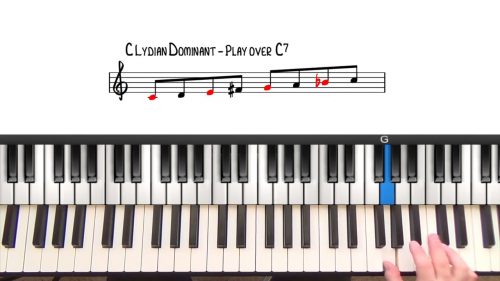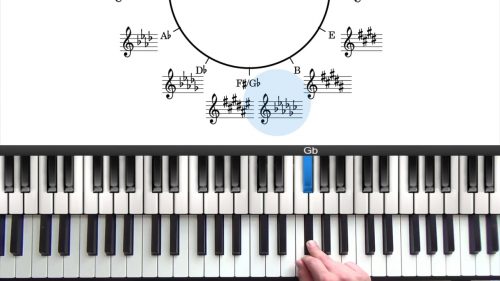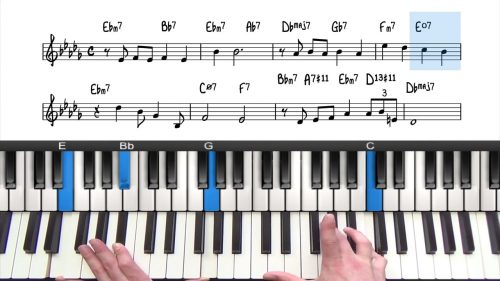Combining Modal & Pentatonic Scales
Welcome to lesson 4 of the minor blues course. In the last lesson, we started out improvisation study by pentatonic scale soloing. We also explored how to start improvising over a minor blues progression with the minor blues scale. In this lesson, we’re going to introduce some more interesting and exotic sounding scales we can use over the form.
What Scales Will We Be Using?
A variety of modal scales can be played over the chords of the minor blues progression. If you are not familiar with modal scales, check out the course on Scales & Modes For Improv
The scales we’ll cover are:
- The Dorian Scale
- The Locrian Scale
- The Melodic Minor Scale
- The Altered Scale
- The Diminished Half-Whole Scale
The Dorian Mode
We start by playing the first 8 bars of the form with the Dorian modes of Cm7 and Fm7. The scale degree formula is R-2-b3-4-5-6-b7 but you can also related the mode to the parent scale. Each Dorian mode contains the same notes as the major scale built a whole step below the root of the Dorian mode.
C Dorian is based off the Bb major scale and contains the exact same notes, just played from C to C,
F Dorian is based off the Eb major scale, containing the exact same notes, but played from F to F
Last 4 Bars: Minor II-V-I Progression In Disguise
In the last four bars of the form, we can think of the Ab7 chord as a tritone substitution of Dm7b5, which would precede the G7 going to Cm7 to create a complete minor 251. We can extend the melodic possibilities by choosing modal scales for D-7b5 and superimposing these over the Ab7.
The Altered G7 Chord – Scale Options
The G7 chord is going to resolve to a C minor chord and so this gives us the opportunity to introduce an altered mode or scale contiaining altered tensions. The G mixolydian mode may not be the most suitable because it is derived from Major Scale Harmony.
Instead, we’re going to use the G altered mode, and the G diminished half whole scale. Both of these scales contain altered tensions which are well suited to playing over the V7alt chord in minor 251 progressions.
A Choice Of Scales For The i Minor Chord
For the final Cm7, we have the option of instead playing a C minor major 7th chord. This is the same as the minor 7th chords except the 7th has been raised up a half step to the major 7th.
This opens up further melodic possibilities. We can play C melodic minor, which has a cool mysterious tone that is a great choice to end the tune.
It’s also worth noting that you can also play this scale over the other Cm7 chords prior in the form to access some more interesting and exotic note choices.
Lesson Downloads
-
Minor Blues Progression PDF File Type: pdf
-
12 Minor Pentatonic Scales File Type: pdf
Practice Tips
-
Experiment with the different modal scales covered in this tutorial.
-
Notice that the major 6th is a characteristic flavor tone of Dorian Scale, and differentiates it from the minor blues scale.
-
The Ab7 can be viewed as an inversion of D-7b5. The D Locrian Mode is then a great choice of scale for melodic improvisation.
-
The G Altered Mode contains the same notes as the Ab Melodic Minor Scale (alsno known as the jazz minor scale) played from G to G.
-
The G Altered Mode contains the b9, #9, b5(#11), and the #5. Lot's of great sounding altered tensions!
-
The G Diminished Half Whole scale is constructed by playing alternating half and whole steps from G to G.
-
The G Dim. HW Scale contains the b9, #9, #4, 5, and 6. The scale is made up of 8 notes which make it useful for playing in 4/4 time.






Hi Matt,
Enjoying your course.
your chart for the D locrian scale does not appear to reflect the notes you play
am i missing something?
robert
Bb should be played instead of a B natural.
Can you explain the use of the (3) when presenting the G Altered Mode scale (Cb have b4(3) and the G Half Whole Diminished Scale (Cb again with b4(3)? Is that something to do with the fact that it’s based on Ab melodic minor?
Great and timely course for me – thank you!
Terri
Hi Terri 👋
Great question here.
When analysing these scales, technically the 4th is flattened.
However, the flat 4 is enharmonically equivalent to the natural 3rd. ‘Enharmonically equivalent’ means that it sounds the same, ie. it is the same note, but it can be spelled differently.
In the same way that the 3rd and 7th define the quality of a chord (major, minor, dominant) the same logic applies to scales.
Whilst from a theoretical standpoint, the 4th is flattened in both altered and diminished scale, from a sonic standpoint we have a scale with the major 3rd and the minor 7th which means that it’s suitable for dominant chords.
When thinking modally, the altered mode is root, b2, b3, b4, b5, b6, b7 of the major scale, but when thinking from a functional standpoint these same scale degrees can be seen as:
Root, b9, #9, 3, #11, #5/b13, and b7 – this gives us the dominant shell 3 and b7, and also all possible alterations which are b9, #9, #11, and #5/b13.
Please check out these related lessons on the altered mode, all taught by myself, where we discuss the theory and also application to jazz standards:
First watch this lesson on Altered Scale Theory where we explore the scale and improvisation principles
Application To “The Nearness Of You”:
Here are 2 lessons which apply altered scale theory to the tune”The Nearness Of You”:
– Targeting Dominant Tensions
– Alterations & Altered Lines
Application To “Misty”:
Here is a lesson where we apply altered arpeggio shapes over the dominant chords in the tune “Misty”
– Altered Arpeggio Patterns
Regarding Diminished Scales, check out this recent workshop hosted by Tuomo:
– Diminished Harmony Workshop
I hope that helps Terri – check out the lessons referenced above and if you have any follow up questions please post them here or on the respective lesson pages.
Talk soon, Hayden